- Table of Content
- 1.EUI is ready f...
- 2.Review of sola...
- 3.The Internatio...
- 4.PROBA2 Observa...
- 5.Geomagnetic Ob...
- 6.The SIDC Space...
- 7.Review of iono...
2. Review of solar and geomagnetic activity
3. The International Sunspot Number by Silso
4. PROBA2 Observations
5. Geomagnetic Observations at Dourbes (22 Jun 2020 - 28 Jun 2020)
6. The SIDC Space Weather Briefing
7. Review of ionospheric activity (22 Jun 2020 - 28 Jun 2020)
EUI is ready for science
shortly after the launch of Solar Orbiter on February 10, the space craft and its onboard instruments needed to be verified. Also the extreme ultraviolet telescoop EUI had to run through the commission.
We can confirm that EUI passed all the tests: opening doors, rotating the filter wheels, computer on/off, pictures with doors closed, pictures with doors open, data-transfer, commanding issues, ...
Solar Orbiter is undoubtedly the first space mission of which the instruments were commissioned straight from people’s home. Even a few years ago, when teleconferencing applications were not as powerful as now, this would have been impossible. But now, only a very short time was needed to adapt to the COVID-way of working. In a glimpse, you had tens of people’s brains together to focus on a single issue, even if they were distributed all over Europe.
After weeks of hard work from home, week days, weekends, after hundreds of teleconferences, ... the EUI team submitted the Commissioning report on June 16. On June 25, EUI passed the 'exam'-teleconference and was officially declared 'Ready for Science'.
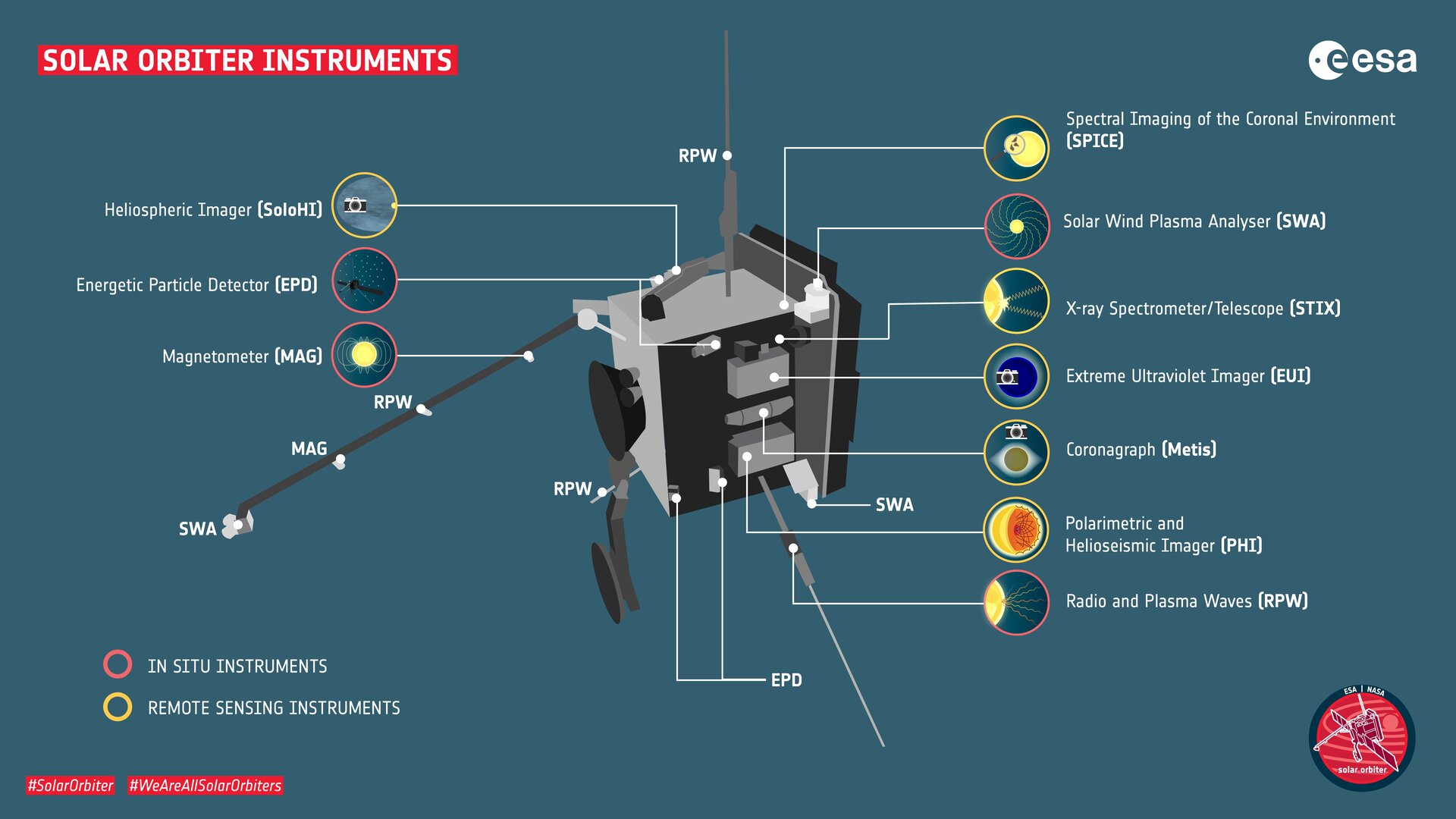
Read the ESA-story: http://www.esa.int/Science_Exploration/Space_Science/Solar_Orbiter/Solar_Orbiter_ready_for_science_despite_COVID-19_setbacks
An STCE colleague says something.
Don't forget to follow EUI on twitter: https://twitter.com/EuiTelescope
Review of solar and geomagnetic activity
SOLAR ACTIVITY
Solar activity was very low. Two northern (SC24 and SC25 polarity) and one southern (SC25 polarity) active region were present on the solar disk, all of which have decayed. The two northern had an alpha magnetic field configuration and were reported by the Catania observatory.
The 10.7cm solar radio flux ranged between 67 and 69 sfu.
A negative polarity equatorial coronal hole (CH) transited the solar disk and crossed central meridian on June23rd, as well as one small, weak extension of the southern polar CH.
The greater than 10 MeV proton flux was at background levels.
The greater than 2 MeV electron flux was nominal to low.
Two filaments erupted, no associated coronal mass ejections (CME) were identified. A narrow coronal mass ejection (CME) was observed on June 2st. The solar source region was located in the North West.
GEOMAGNETIC ACTIVITY
The solar wind was slow to moderate, with a small enhancement lasting June 27-28th. It ranged between 280 and 430 km/s, with Bz varying between -8 and +9 nT. The interplanetary magnetic field was in the negative sector (pointing towards the Sun), with an exception of June 24-26th.
Geomagnetic activity was quiet to unsettled, with an isolated active period.
The International Sunspot Number by Silso
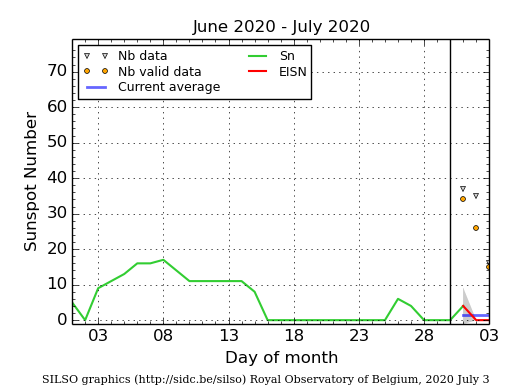
The daily Estimated International Sunspot Number (EISN, red curve with shaded error) derived by a simplified method from real-time data from the worldwide SILSO network. It extends the official Sunspot Number from the full processing of the preceding month (green line). The plot shows the last 30 days (about one solar rotation). The horizontal blue line shows the current monthly average. The yellow dots gives the number of stations that provided valid data. Valid data are used to calculate the EISN. The triangle gives the number of stations providing data. When a triangle and a yellow dot coincide, it means that all the data is used to calculate the EISN of that day.
PROBA2 Observations
Solar Activity
Solar flare activity was very low during the week.
In order to view the activity of this week in more detail, we suggest to go to the following website from which all the daily (normal and difference) movies can be accessed: https://proba2.oma.be/ssa
This page also lists the recorded flaring events.
A weekly overview movie (SWAP week 535): http://proba2.oma.be/swap/data/mpg/movies/weekly_movies/weekly_movie_2020_06_22.mp4
Details about some of this week's events can be found further below.
If any of the linked movies are unavailable, they can be found in the P2SC movie repository: https://proba2.oma.be/swap/data/mpg/movies/
Tuesday Jun 23
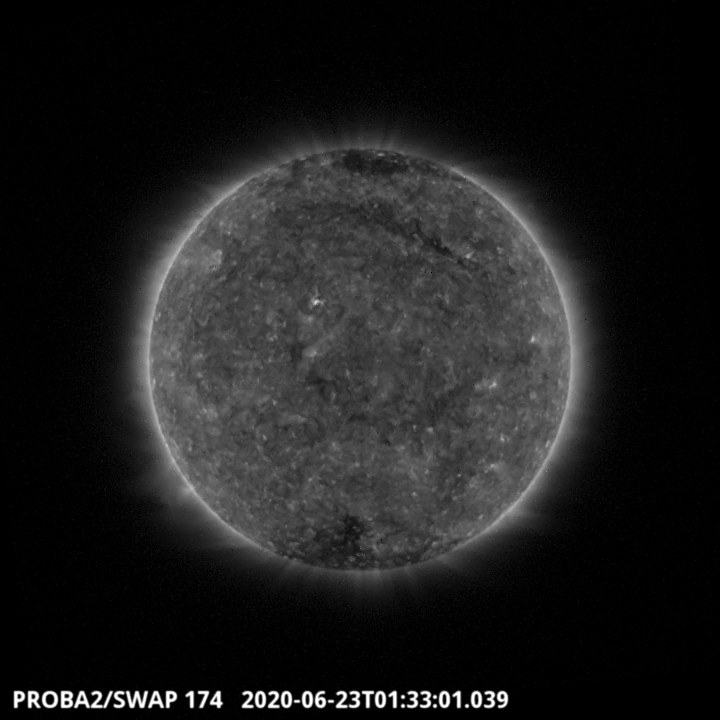
An equatorial coronal hole has transited the solar disk and has crossed the central meridian on 2020-Jun-23. Find a movie of the events here (SWAP movie) http://proba2.oma.be/swap/data/mpg/movies/20200623_swap_movie.mp4
Saturday Jun 27
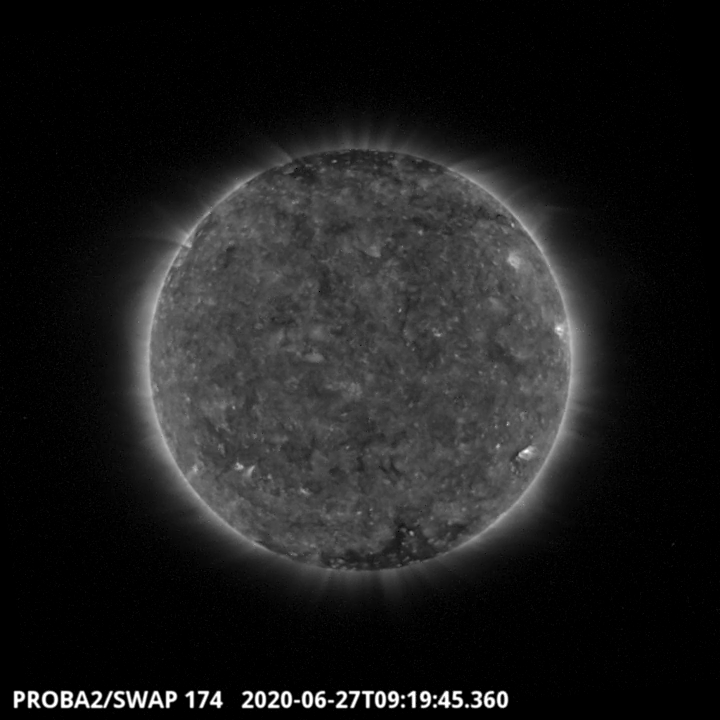
An active region erupted (reported as A1.3) on the South hemisphere of the solar disk on 2020-Jun-27 around 9:19UT.
A movie of the events (SWAP movie): http://proba2.oma.be/swap/data/mpg/movies/20200627_swap_movie.mp4
The SIDC Space Weather Briefing
The Space Weather Briefing presented by the forecaster on duty from July 21 to 28. It reflects in images and graphs what is written in the Solar and Geomagnetic Activity report.
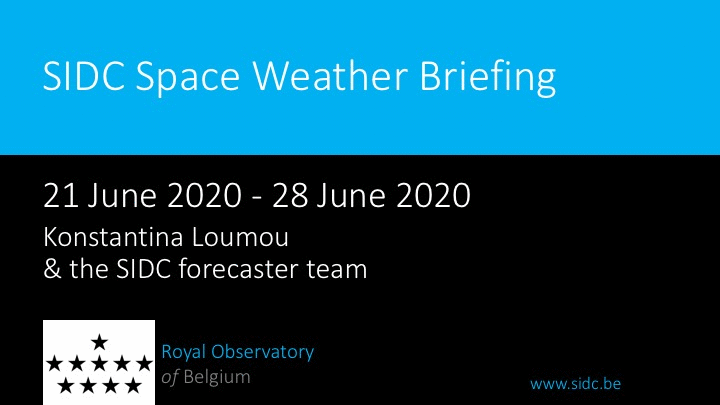
The pdf-version: http://www.stce.be/briefings/SIDCbriefing-20171106.pdf
The automatically running presentation: http://www.stce.be/briefings/SIDCbriefing-20171113.pdf
Review of ionospheric activity (22 Jun 2020 - 28 Jun 2020)
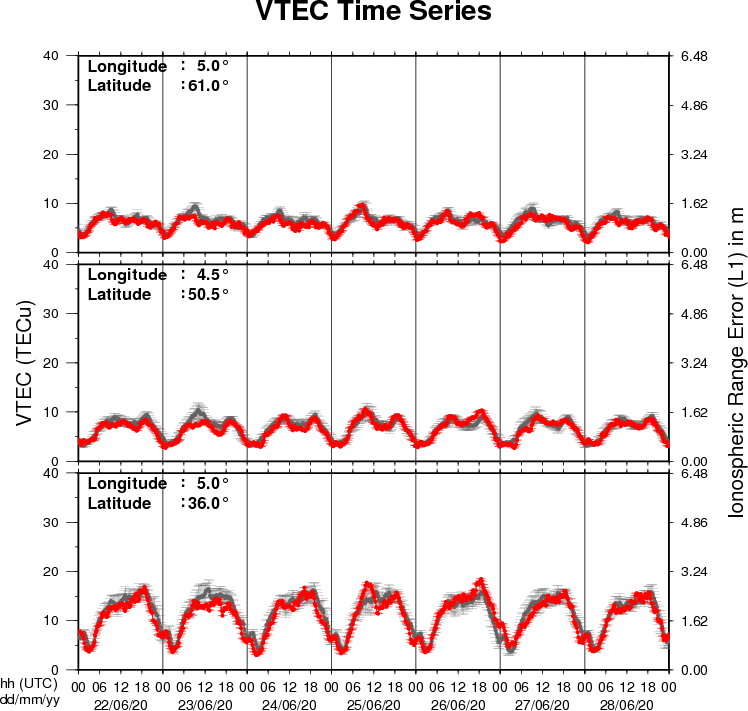
The figure shows the time evolution of the Vertical Total Electron Content (VTEC) (in red) during the last week at three locations:
a) in the northern part of Europe(N61°, 5°E)
b) above Brussels(N50.5°, 4.5°E)
c) in the southern part of Europe(N36°, 5°E)
This figure also shows (in grey) the normal ionospheric behaviour expected based on the median VTEC from the 15 previous days.
The VTEC is expressed in TECu (with TECu=10^16 electrons per square meter) and is directly related to the signal propagation delay due to the ionosphere (in figure: delay on GPS L1 frequency).
The Sun's radiation ionizes the Earth's upper atmosphere, the ionosphere, located from about 60km to 1000km above the Earth's surface.The ionization process in the ionosphere produces ions and free electrons. These electrons perturb the propagation of the GNSS (Global Navigation Satellite System) signals by inducing a so-called ionospheric delay.
See http://stce.be/newsletter/GNSS_final.pdf for some more explanations ; for detailed information, see http://gnss.be/ionosphere_tutorial.php
